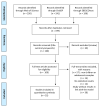Role of Callous and Unemotional (CU) Traits on the Development of Youth with Behavioral Disorders: A Systematic Review
- PMID: 33925165
- PMCID: PMC8125599
- DOI: 10.3390/ijerph18094712
Role of Callous and Unemotional (CU) Traits on the Development of Youth with Behavioral Disorders: A Systematic Review
Abstract
Numerous studies have shown that youth with behavioral disorders (BD) present an increased risk for developing severe and persistent antisocial behaviors in adulthood. Retrospective research notes that not all children and adolescents follow a negative trajectory and explains this heterogeneity in particular by the severity of CU traits. Our study examines how these traits affect the functioning of children and adolescents with BD.
Method: A systematic literature review conducted through various databases and using different keywords made it possible to analyze 52 studies published from 2015 to 2020 that measured the bidirectional effects of CU traits on the functioning of young.
Results: Out of the 52 studies, 47 analyzed links between CU traits and neurobiological or mental health, 20 examined family and school contexts, eight focused on social adjustment, 10 on social interactions and 19 measured links with cognitive functioning, especially executive functions.
Conclusion: Consistent with previous recommendations in the field, our findings emphasize the importance of assessing the presence of UC traits in early childhood to prevent the emergence of comorbid disorders and to target multimodal (early) interventions to influence the life trajectories of youth with high CU traits.
Keywords: callous-unemotional traits; childhood; functioning; review.
Conflict of interest statement
The authors declare no conflict of interest.
References
-
- American Psychiatric Association Diagnostic and Statistical Manual of Mental Disorders. American Psychiatric Association; Arlington, VA, USA: 2013.
Publication types
MeSH terms
LinkOut - more resources
Full Text Sources
Other Literature Sources


